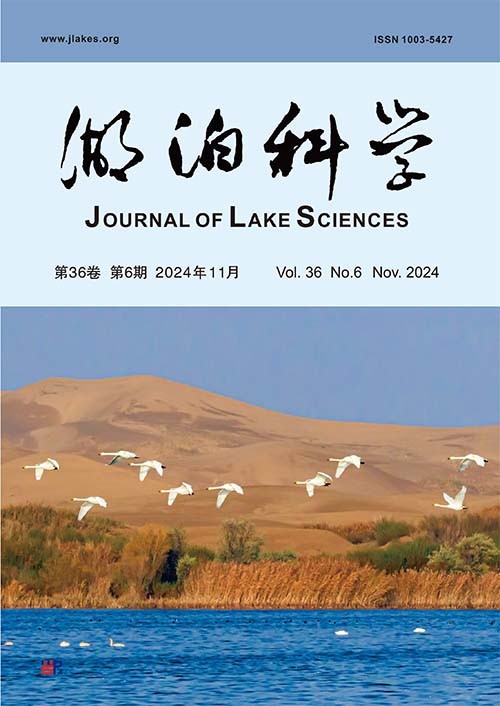2007年以来基于质量平衡的太湖总磷污染负荷计算与分析
Q2 Earth and Planetary Sciences
引用次数: 0
摘要
磷是太湖富营养化的关键性指标,为了解太湖总磷内、外源变化趋势及特征,从总磷污染负荷动态平衡角度分析太湖总磷主要来源与总磷浓度高位波动的原因,本研究基于2007年以来长时序水量水质监测资料和调查数据,开展了太湖进出各途径的总磷负荷质量平衡估算及分析。结果表明,2007—2020年入湖河道输入总磷负荷为1835~2799 t,占太湖总磷负荷的55%~73%,是外源输入最主要的途径;大气干湿沉降输入353~1380 t,占太湖总磷负荷量的12%~38%,是太湖总磷外源输入的第二大途径;太湖水体中总磷负荷量约占8%~15%。出湖河道输出总磷负荷量为516~906 t,占太湖总磷负荷量的13%~30%;水生动植物捕捞总磷负荷量为115~312 t,占太湖总磷负荷量的4%~12%,水厂输出占2%~3%左右;约41%~74%的总磷负荷量滞留于太湖湖体中,成为影响太湖总磷浓度的重要内源。同时,太湖地区气温升高、太湖水体流动速度加快一定程度上又加速了内源污染释放,使其成为总磷改善的限制性因素。;Phosphorus is the main indicator of eutrophication in Lake Taihu. In order to understand the trends and characteristics of the internal and external total phosphorus (TP) load in Lake Taihu, the main sources of TP in the lake and the reasons for the high fluctuation of TP concentration were analysed from the dynamic equilibrium of TP pollution load. The mass balance of TP load in different ways into and out of the lake was estimated and analysed based on a long series of water quality monitoring data. The results showed that the input TP load of rivers was about 1835-2799 t during 2007-2020 as the main source, accounting for 55%-73% of the TP load in Lake Taihu. The TP load transported by dry and wet deposition was 353-1380t, which accounted for about 12%-38% and was the second largest input pathway of TP load in Lake Taihu. Meanwhile, 8%-15% of the TP load was retained in the water of Lake Taihu. However, the TP discharged from the outlet river was about 516-906 t, accounting for about 13%-30% of the TP load in Lake Taihu; the TP removal by harvesting aquatic animals and plants was 115-312 t, accounting for 4%-12% of the TP load in Lake Taihu; and the percentage of TP output by drinking water extraction was about 2%-3%. Therefore, about 41%-74% of the TP load remained in the lake, which is an important endogenous factor influencing the epilimnetic TP concentration in Lake Taihu. In addition, the increase in temperature and water flow velocity in Lake Taihu had both accelerated the release of TP from sediment into water, resulting in sediment being one of the limiting factors for TP control.本文章由计算机程序翻译,如有差异,请以英文原文为准。
Calculation and analysis of total phosphorus pollution load based on mass balance in Lake Taihu since 2007
磷是太湖富营养化的关键性指标,为了解太湖总磷内、外源变化趋势及特征,从总磷污染负荷动态平衡角度分析太湖总磷主要来源与总磷浓度高位波动的原因,本研究基于2007年以来长时序水量水质监测资料和调查数据,开展了太湖进出各途径的总磷负荷质量平衡估算及分析。结果表明,2007—2020年入湖河道输入总磷负荷为1835~2799 t,占太湖总磷负荷的55%~73%,是外源输入最主要的途径;大气干湿沉降输入353~1380 t,占太湖总磷负荷量的12%~38%,是太湖总磷外源输入的第二大途径;太湖水体中总磷负荷量约占8%~15%。出湖河道输出总磷负荷量为516~906 t,占太湖总磷负荷量的13%~30%;水生动植物捕捞总磷负荷量为115~312 t,占太湖总磷负荷量的4%~12%,水厂输出占2%~3%左右;约41%~74%的总磷负荷量滞留于太湖湖体中,成为影响太湖总磷浓度的重要内源。同时,太湖地区气温升高、太湖水体流动速度加快一定程度上又加速了内源污染释放,使其成为总磷改善的限制性因素。;Phosphorus is the main indicator of eutrophication in Lake Taihu. In order to understand the trends and characteristics of the internal and external total phosphorus (TP) load in Lake Taihu, the main sources of TP in the lake and the reasons for the high fluctuation of TP concentration were analysed from the dynamic equilibrium of TP pollution load. The mass balance of TP load in different ways into and out of the lake was estimated and analysed based on a long series of water quality monitoring data. The results showed that the input TP load of rivers was about 1835-2799 t during 2007-2020 as the main source, accounting for 55%-73% of the TP load in Lake Taihu. The TP load transported by dry and wet deposition was 353-1380t, which accounted for about 12%-38% and was the second largest input pathway of TP load in Lake Taihu. Meanwhile, 8%-15% of the TP load was retained in the water of Lake Taihu. However, the TP discharged from the outlet river was about 516-906 t, accounting for about 13%-30% of the TP load in Lake Taihu; the TP removal by harvesting aquatic animals and plants was 115-312 t, accounting for 4%-12% of the TP load in Lake Taihu; and the percentage of TP output by drinking water extraction was about 2%-3%. Therefore, about 41%-74% of the TP load remained in the lake, which is an important endogenous factor influencing the epilimnetic TP concentration in Lake Taihu. In addition, the increase in temperature and water flow velocity in Lake Taihu had both accelerated the release of TP from sediment into water, resulting in sediment being one of the limiting factors for TP control.
求助全文
通过发布文献求助,成功后即可免费获取论文全文。
去求助
来源期刊

湖泊科学
Environmental Science-Water Science and Technology
CiteScore
3.70
自引率
0.00%
发文量
3253
期刊介绍:
Journal of Lake Sciences (ISSN 1003-5427) was founded in 1989 and is jointly sponsored by Nanjing Institute of Geography and Lake Sciences, Chinese Academy of Sciences and Chinese Society of Oceanology and Limnology. It mainly reports the latest research results on the changes in resources, ecology and environment of lakes (including reservoirs) and their basins under the interaction between man and nature. It publishes theoretical or applied research papers, briefs and reviews on various disciplines related to lake science (such as physics, chemistry, biology, ecology, geology, geography, etc.) as well as lake engineering and integrated basin management. Since 2006, the journal has been changed to a bimonthly publication, published on January, March, May, July, September and November 6 by Science Press.
 求助内容:
求助内容: 应助结果提醒方式:
应助结果提醒方式:


